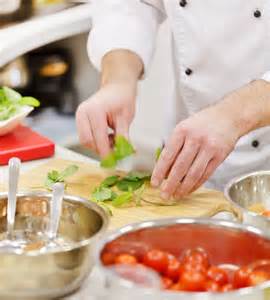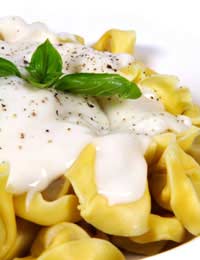Quick Pasta Sauces

Even the most culinary challenged can manage to boil a kettle and throw a few spaghetti strands in a pan. However, pasta doesn't have to mean a jar of cheap tomato sauce and value-range penne. As the mainstay of the Italian diet, it comes in many guises and is just as likely to be seen on the menus of the classiest restaurants as it is in halls of residence. With just a little know-how you can create your own quick and easy pasta sauces and save yourself money, as well as (hopefully) tucking into a sauce that tastes superior to anything you pour out of a jar.
Basic IngredientsPasta sauces tend to generally be either tomato- or cream-based, obviously with a number of variations in between.
TomatoesYou can either use canned tomatoes (plum or chopped) or fresh. Passata (sieved tomatoes) is handy to keep in stock and tomato purée is an absolute essential.
CheeseMascarpone, cream cheese and feta will all come in useful and, of course, Parmesan to grate over the finished dish.
HerbsIf there's a choice always opt for fresh herbs, as the flavour is so much better. Basil is a classic ingredient in a number of sauces and if you're a keen cook you should consider saving money and growing your own - you don't need a garden; a window box will do the trick. Thyme and oregano are also widely used.
ExtrasOlives are great for adding flavour to all kinds of sauces, while sun-dried tomatoes will really jazz up a tomato sauce. You can buy these in packets or jars - either is fine. Fresh chillies will add a kick if you want to turn up the heat and garlic is welcome in pretty much any sauce you can think of.
Getting SaucyHere are three really quick recipe ideas:
Tomato and BasilThese flavours work very well together. This will serve 2-3 people.
- Fry a chopped onion in a little olive oil,
- add 2 chopped garlic cloves and fry until softened.
- Pour in two cans of chopped tomatoes and stir.
- Cook this for about 30 minutes. Roughly chop a handful of basil leaves and add most of them to the pan.
- Season with salt and pepper and sprinkle the remaining basil over the finished plates.
- Fry a chopped red onion in olive oil,
- add a chopped garlic clove and fry for a minute or two.
- Add four or five chopped, sun-dried tomatoes and 1 tub of crème fraiche.
- Drain and remove any skin or bones from a small can of salmon and add this to the pan.
- Allow to simmer very gently for about 5 minutes.
- Serve with fettuccine or penne.
- Fry a chopped onion and a chopped celery stick in olive oil until softened.
- Add a finely chopped carrot.
- Add 500g of minced beef and cook until it has browned.
- Add a can of chopped tomatoes, half a can of water, a large dash of red wine and a good pinch of dried thyme and oregano.
- Bring to a simmer, cover the pan and cook for about 45 minutes, until the sauce has reduced.
Hopefully these ideas will get your creative juices running. All sauces are adaptable so add and subtract at will, depending on what you like.
Ten Ideas for Jacket Potatoes

Along with tuna pasta the jacket potato is probably the ultimate student food. They're cheap, they're very quick and easy to prepare and they're pretty filling as well. While baked beans and grated cheese is probably the topping that adorns most baked potatoes around the country, there are plenty of other ideas that are just as quick but will add a bit of variety to a weekday dinner.
Cooked to Perfection
One of the great appeals of jacket potatoes is that they can be ready in a matter of minutes if you cook them in the microwave. While they're spinning around doing their thing, you can rustle up the topping and can pretty much have dinner ready in the ad break of your favourite telly programme. However, if you want the full experience, nothing beats the crispy skin of an oven-baked potato. This does take time but if you're organised you just pop it in the oven about an hour-and-a-half before you want to eat and there's really not much else too it - just a bit of waiting.
A good compromise is to cook the potato in the microwave until it's almost cooked through and then pop it in to a preheated oven to finish it off for 30 minutes or so. Whether you're cooking yours in the oven or microwave, always wash the potato first then prick it all over with a fork. For a really crispy skin, you can rub a little oil over it (for oven cooking).
Once it's cooked, try one of these toppings:
Beans and Cheese
This is the classic filling. Heat the baked beans - they work really well if the sauce has been reduced down and the beans have started to go a bit mushy. Grate a good amount of strong cheddar cheese. Split the potato, add some butter then pour over the beans. Sprinkle the cheese over the top and watch it melt into the beans. Delicious.
Chilli and Soured Cream
Chilli con carne works really well with jacket potatoes and this is great if you have some in the fridge or freezer. Heat it separately then spoon over the jacket potato. Top with some soured cream.
Tuna, Red onion and Pepper
Finely chop half a red onion and half a red pepper then place in a bowl with a drained can of tuna. Mix in some mayonnaise and season with freshly ground black pepper. This makes enough for two potatoes.
Mushrooms and Cream
Melt a little butter in a pan, add a couple of handfuls of chopped mushrooms (a mix of mushrooms is best) and fry until they're soft and cooked through. Drizzle in some single cream and heat through. The cream will soften the potato and the mushrooms taste great.
Prawns with Mayonnaise
A handful of cooked prawns is all you need for a glamorous topping for your spud. Defrosted, frozen, cooked prawns are ideal for this. Just heat them through thoroughly and mix with a little mayonnaise.
Curry
A great way to use up leftover curry. Most curries work well as a topping for jackets - just heat through thoroughly and spoon over the potato.
Coleslaw
Perfect for a summer lunch or snack and there's really nothing for you do apart from open the carton and spoon the coleslaw over your spud.
Bacon
Crispy bacon rashers work really well as a simple topping for baked potatoes.
Cream Cheese and Chives
Choose a full-fat cream cheese and don't be shy! Chop some chives and scatter these over the top.
Bolognese
Hold back a little of your Bolognese sauce when you're making spag bol. A couple of spoons of this on an oven-baked jacket is sufficient for a tasty meal.
These are just a few of the many hundreds of topping ideas for everyone's favourite quick meal. A jacket potato is very nutritious so it's a great fall back when you can't find inspiration or you don't have much time to cook dinner.
How to Make Basic Sauces

Having a couple of classic sauce recipes up your sleeve will help tremendously when it comes to livening up bland dishes or creating something exciting out of leftovers or odds and ends in the fridge.
Classic Cheese Sauce
This is a really versatile sauce that can be used for everything from lasagne to cauliflower cheese and for pouring over cooked meat. It's quick and easy to make and once you've tried it you'll never go back to packet sauces again.
Ingredients
- 600ml milk (that's a pint to you and me)
- 40g plain flour
- 40g butter
- 75g Cheddar cheese grated (the stronger the better)
- Salt and freshly ground black pepper
Method
Mix the flour with enough of the milk to create a paste then very gradually add the rest of the milk, using a whisk to stir it constantly so you don't get any lumps.
Pour into a pan and heat gently, adding the butter. Increase the heat and stir constantly until the sauce begins to simmer and thicken.
Keep stirring for about 3-4 minutes, until it's a good consistency. Sprinkle in the cheese and seasoning and stir until it has melted. That's it!
Tomato Sauce
This is a great staple for any kind of pasta shape and you can add all sorts of other ingredients to this basic recipe, such as chilli, olives, mince meat or cooked chicken.
Ingredients
- 1 tbsp extra virgin olive oil
- 1 small onion, finely chopped
- 2 garlic cloves, finely chopped
- 1 large can chopped tomatoes
- 25g fresh basil, roughly chopped
Method
- Heat the oil in a large shallow pan and fry the onion over a gentle heat for about 5 minutes.
- Add the garlic, cook for 1 minute then stir in the tomatoes.
- Increase the heat to a simmer and cook for about 5 minutes, then stir in the chopped basil. Stir and serve.
How Much Things Actually Cost

If you're not used to doing the weekly shop a trip to your local supermarket can be a bit of an eye-opener. Plus, if you don't look at the prices of everything you're merrily dropping into your basket, you'll probably get a bit of a shock when you reach the checkout and have to put your hand in your pocket to pay.
The harsh reality is that food costs money and maybe you will start to realise why your parents always told you to put things back if you tried to add them to the trolley when you were out shopping! If you're used to being able to go to the kitchen and help yourself to whatever you fancy eating, or sit down to a nice, home-cooked meal every evening, shopping and cooking for yourself will certainly be a new and interesting experience. When everything is laid on at home it's easy to think of food and drink as being free. However, it will actually use up a large chunk of your budget while you're at college so it's good to have some idea of how much things really cost and how you can easily economise, whilst still eating well.
Fruit and Veg
These staples of a daily diet can actually add up if you don't keep a close eye on prices. If you enjoy exotic fruit and unusual or out-of-season vegetables, you might be digging a little deeper into your pocket that you'd hoped. If you stick to the basics such as carrots, potatoes, cabbage, onions, apples and bananas, you shouldn't go too far wrong. Make these (and other lower priced items) your staples and then top them up with different extras each week for some variety.
Look out for special offers on bulk buys or seasonal items. You can also find some bargains on packaged produce that's due to be used the same day. As packaging will always have a sell by/use by date, it's a good tip to look out for reductions here. Just make sure you buy things you will actually use, as there's not much point saving a few pence and then binning the food a few days later as you haven't eaten it.
Meat
Depending on what type of meat you like, you can end up spending a fair amount on this. Obviously the economy versions of things like sausages and burgers will always represent a bit of a bargain but it's really up to you as to what you want to put in your body! Chicken can be good value, especially if you buy bigger packs and freeze the portions individually. Thighs and wings are generally cheaper than breast fillets and these are great for using in dishes such as curries and casseroles. Also, buying a whole chicken can actually work out cheaper than buying the equivalent amount of portions. You can then either feed the whole house or cook the whole chicken and use what's leftover for meals the following day.
Dairy Products
Speciality cheeses can be very pricey so it's more economical to stick to more popular varieties and buy larger packs, if you eat a lot of cheese. Buy large cartons of milk as this works out cheaper than purchasing individual pints and likewise, larger cartons of yogurt can be more economical than individual tubs.
Rice and Pasta
Again, it pays to buy in bulk here. Try shopping at ethnic supermarkets for rice, as you'll be able to purchase huge bags of rice at a fraction of the price that the equivalent amount would cost in the supermarket. Stick to the more popular pasta shapes as these will generally come in larger pack sizes and be cheaper than more unusual shapes.
These are just a few of the regular items that you might be buying. As long as you keep an eye on what you're putting in the trolley and how much it costs, you should be able to plan the amount you spend. It's worth spending a little more time in the supermarket and comparing prices of different brands and different varieties of your favourite foods - you could save pounds!